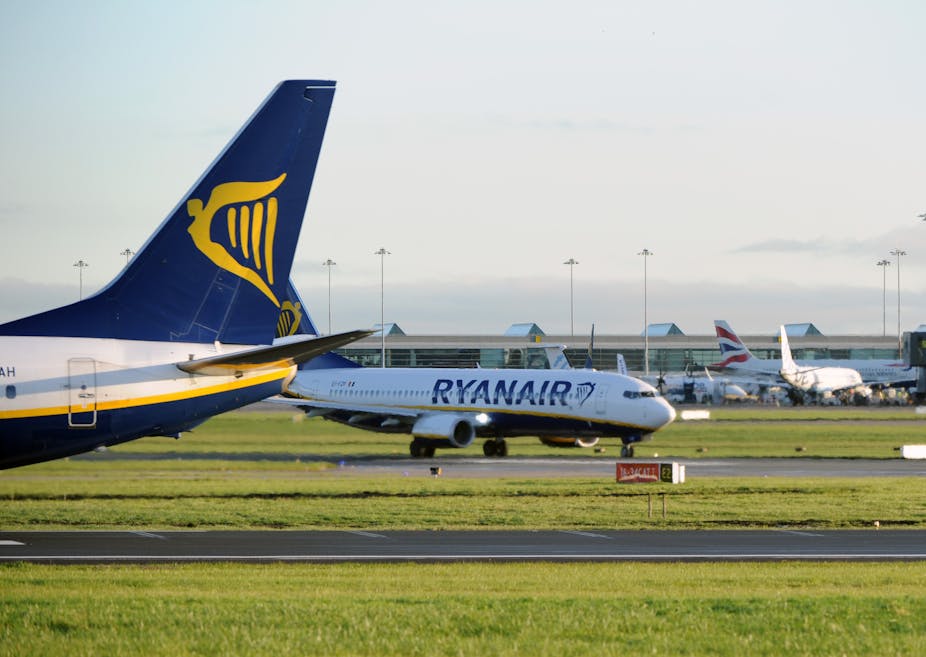Having once threatened to “cut off his own hands” rather than sign a deal with a trade union, Ryanair chief executive Michael O’Leary’s decision to recognise pilot unions on December 15 is a massive U-turn. But it was deemed necessary to stop the threat of pilot strikes over the busy Christmas period.
There are two different ways of seeing this change to a policy held dear for more than 30 years. On the one hand, it could be seen as a general shift to be an all-round nicer company. On the other it is a marker of the external pressures Ryanair is facing at a time of turbulence for the airline, as well as bigger changes that could be afoot for the company.
From Ryanair’s viewpoint, the decision to recognise pilot unions can be seen as a continuation of its “Always Getting Better” programme launched in March 2014. This heralded – in the words of O’Leary – “a revolutionary change”. After years of famously disrespecting customers, the company put a new emphasis on keeping them happy. It introduced new services like a more user-friendly booking procedure, allocated seating, and better cabin baggage allowances. The new outlook was explained by the company as previously spending so much effort building the airline for 30 years, it only now had time to listen to customers.
The handling of its pilot rostering fiasco in September in which hundreds of flights were cancelled also showed a softening in Ryanair’s attitude. It gave in to demands by the UK Civil Aviation Authority to advise and remunerate affected customers, when in the past it has fought back against the regulator on numerous occasions. With pressure increasing from pilots in Germany, Ireland, Italy, Portugal and Spain, O’Leary explained that recognising trade unions was part of “putting the needs of our customers first and avoiding disruption to their Christmas flights”.
It is not unusual for low-fare carriers to recognise trade unions. Both EasyJet and Southwest Airlines – the model that Ryanair’s low-cost strategy is based on – have long negotiated directly with unions. In a radio interview on the morning of the announcement, Ryanair’s chief people officer simply said, “it’s the right thing to do”.
A more cynical take on Ryanair’s motives would view the timing of the “Always Getting Better” programme with several consecutive sets of disappointing quarterly results (including two profit warnings); at a time when its arch-rival Easyjet exceeded financial expectations. Similarly, the pilot rostering issue could be related both to Norwegian Air poaching its staff and by management being distracted by an attempted Alitalia takeover.
So the decision – and its timing – to recognise trade unions could also be interpreted as a result of external pressures. The Christmas rush would be one of the worst moments for a strike to take place and this could be seen as a holding strategy to take the fight into the quieter months of January and February 2018. Christmas is also the time when lots of people make advanced bookings for their summer holidays. This is critically important as flight uncertainty tends to hurt these, making the timing all the more crucial to smooth things over with pilots.
Turbulence ahead
The immediate impact of Ryanair’s announcement could be seen in its share price. It fell by over 8%, wiping more than €1 billion off the company’s value as investors associate unions with increased costs. As unions representing cabin crew, ground handlers and other categories of staff also seek negotiating rights, much management time will be taken up in agreeing deals.
In this regard, the newly-appointed chief operations officer, Peter Bellew, should prove particularly useful as he has now gained valuable experience of working with airline unions in his previous post at Malaysian Airlines. Free collective bargaining agreements can be expected to push up costs, especially in the context of a looming pilot shortage, with some estimates warning that 600,000 new pilots are needed in the next 20 years to keep up with demand.
While Ryanair enjoys a healthy gap in cost per seat figures compared to its rivals, competition is set to be fierce – not least because EasyJet has a new CEO with a lot to prove.
Longer term, the fundamentals of Ryanair’s low-cost, high-volume business model continue to look solid and its aircraft acquisition orders are on course to carry 200m passengers by 2024.
Ryanair is also looking to expand its offering. Market development in the form of transatlantic services (long-haul being another area that the incoming COO Bellew now has experience of) would further add to its ambitious forecast, as current fleet orders relate only to Boeing 737 aircraft, which lack the range required for non-stop flights.
But perhaps the most intriguing question arising from the last four months of upheaval in Ryanair lies in the repercussions for long-time boss O’Leary. O'Leary reportedly “just survived moves to push him off his pedestal” at the company’s September AGM – after 23 years at the helm. So there’s lots to look out for in 2018 when it comes to Ryanair’s future. With the aforementioned Bellew seemingly playing a central role in directing the company, we could even witness a changing of the guard.

